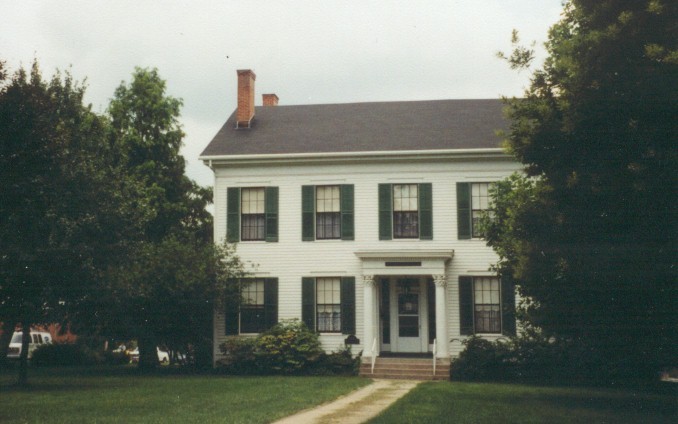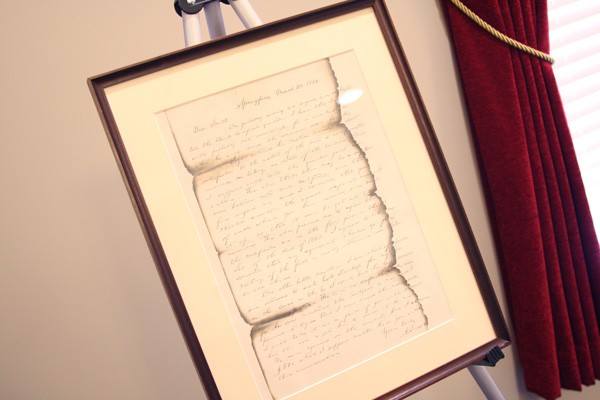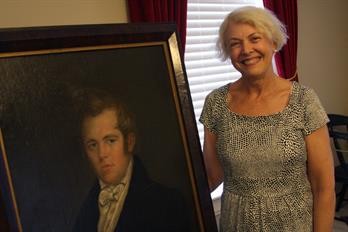David A. Smith House
Introduction
Text-to-speech Audio
Images
Google Images. Picture taken

A portrait of David A. Smith a former trustee of Illinois College, along with a framed copy of a letter from President Abraham Lincoln to Smith was recently donated to the college by Smith’s great-great-great granddaughter, Carolyn Lansden Whittle.

Carolyn Lansden Whittle with the portrait that she had donated with her great-great-great grandfather, David A. Smith. Illinois College History

Backstory and Context
Text-to-speech Audio
Between the years of 1852-1854 David A. Smith purchased this estate and built a house on it for an estimated cost of $15,000. This Federal-style two story house has the original construction from 1854, which was designed by David A. Smith himself. This house was made from a foundation of stone and brick, walls of wood, and an asphalt shingle roof. The Federal style architecture includes symmetrical, elegant, and simple characteristics. The grand porch on the front of the house is Greek Revival Style because it has an ornate design, and a few columnns. The house included 16 rooms for residence, 6 staircases, and 11 fireplaces. A walnut staircase is featured in the foyer. This estate also included orchards, pastures, smokehouses, and outbuildings that went south to the Mauvaisterre Creek.
David A. Smith was an attorney in the city of Jacksonville, and he was also a great friend of our sixteenth President of the United States, Abraham Lincoln. When Lincoln had legal business in Jacksonville, he used Smith’s law office as his headquarters. There are records that indicate that Lincoln and Smith were associated with 68 cases as either co-counselors or opposing attorneys.
Today, The David A. Smith house is still in use on Illinois College’s campus. The Federal-style home houses the three women’s Literary Societies, the Gamma Deltas, the Chi Betas and the women of Sigma Phi Epsilon. There is a parlor for all of them to use, but the Delts use a room on the main floor while the Betas and the Sig Phip’s have rooms on the second floor. The attic is used by all the groups but there is also a dining room, a kitchen and an apartment at the back of the house that are also in use by the societies.
In 2013 Smith’s great-great-great granddaughter Carolyn Lansden Whittle donated a portrait of her grandfather along with a letter from President Lincoln to Smith. Smith was an abolitionist and a former trustee of Illinois College. The oil painting had been hanging in Whittle’s home in Westchester County, NY for more than 40 years and includes a brass plaque stating “David A. Smith, 1804-1865.” Whittle believes it was painted around 1840 to 1850, and the artist of the portrait is unknown.
Rumor has it that the David A. Smith house is also one of the most haunted sites on Illinois College’s campus. The story goes as follows:
There are several versions of the historic legend of the ghost in the David A. Smith House, but all of them claim that she is the daughter of the original owner and that her name was Effie Smith. Effie was being courted by a young man from town and they eventually became engaged. When he proposed to her, he gave her a diamond ring and she was said to have scratched the diamond against her bedroom window to see if it was real. When Effie realized that the diamond was not fake, she then etched her signature into the glass and her name remained for years after. The original window has been removed recently and the small and unusual piece of history has been lost forever. The story begins to take different paths after the first legend had been told. In one version of the story, David Smith did not approve of his daughter’s new fiancée and he literally locked Effie into a closet one day when the man came looking for Effie. Fearful of her father, the young man hid himself in a small room that was only accessible from the attic. The man then nailed himself in the room to try and escape from David Smith. He later died in the room. Per students who have been in the attic, the nails are still visible today. They are nailed from the other side of the door. When Effie learned that her lover had passed on, she then threw herself out from an upstairs window and died during the fall.
In
the second version of the story, Effie’s young man had left the area to fight
in the Civil War. Every day, Effie climbed up to the attic and watched for him
to return. When she later learned that he had been killed in battle, she had committed
suicide by once again, jumping out of the window.
Another story of the legend is that after Effie was neglected by her lover and
she again committed suicide. Regardless of what happened, the story says that
she had killed herself and has since then returned to haunt the house.
Effie’s rocking chair is still located in the attic. The chair faces the window
looking out where she had “sat” waiting for her lover to return from war.
Legends say that if you move the chair away from the window, leave the attic
and then come back, the chair will have returned to its original position. This
window is in a storage area for the Chi Beta literary society and, every year
they test the chair and discover that the story is true. A past Illinois
College student walked into the room one day and the door suddenly slammed
closed behind her. It is also not uncommon for cold air to suddenly fill the
room in the attic. Even though for years the windows were painted shut, it was
said that ice cold wind would often come from the window with Effie’s name
etched on the glass.
Another interesting feature in the David A. Smith house is the tunnel that once
exited from the dirt basement. This tunnel was once supposed to have been connected
to other buildings on campus and was said to have been used during the years of
the Underground Railroad. As connected with the abolitionist system there were
secrets that were always kept, and no records exist. Therefore, this legend
cannot be proved to see if the stories are true. Today, the tunnel is boarded
up and the stories continue.
The David A. Smith adds personality to the history loving city, Jacksonville, Illinois; but Illinois College’s campus would not function the same without it either.
Sources
Bellatti, Sandy. David A. Smith House. Sandy Bellatti, 2015. "Looking for Lincoln, www.ic.edu/Customized/Uploads/ByDate/2015/April_2015/April_27th_2015/DavidASmithHouseBrochure55710.pdf. Accessed 8 Nov. 2016.
Jacksonville Area Convention & Visitors Bureau. "Jacksonville Area Convention & Visitors Bureau." Jacksonville Area Convention & Visitors Bureau, jacksonvilleil.org/david-a-smith-house/. Accessed 8 Nov. 2016.
Taylor, Troy, Mr. "Illinois College." Haunted Illinois, edited by Illinois College Students, 2010, www.prairieghosts.com/ilcollege.html. Accessed 8 Nov. 2016.
